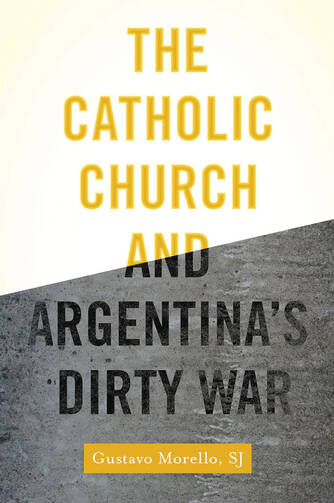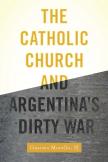How could a country that was 90 percent Catholic “disappear” Catholic priests and seminarians?
Oxford University Press. 240p $74
The book review editor at this magazine called with an assignment. I’d like you to review a book about the Catholic Church and Argentina’s dirty war, he said.
Sure, I replied.
I had read with interest the coverage of Jorge Mario Bergoglio’s election to the papacy and was looking forward to a book, written by a Jesuit, about what had happened when Pope Francis was the Jesuit provincial in Buenos Aires. There had been some accusations, most of them disputed in the end by the priests involved, that their superior had been less than supportive when the junta’s men came for them.
Here, I thought, I would get the inside story from a person in a position to know the true inwardness of what went on in the mid-1970s in Argentina. Imagine my chagrin on reading in the book’s Preface: “Obviously, interest in the pope’s role in the ‘Dirty War’ has increased. Father Jorge Bergoglio, SJ is occasionally mentioned in these pages, but this is not a book about him or his experience as Jesuit provincial in Argentina.”
Oh well.
I have spent 40 years working as a journalist, much of it as an editor, trying to convince writers that they should “show” what happened rather then “tell” it. It requires a keen appreciation of detail, a relentless curiosity and an unslakeable thirst for truth. It also helps to be gifted with an ability to imagine a scene after having interviewed enough sources to make sure what you are showing really happened. We want it to be true.
Journalistic truth is akin to scientific truth: It has to be able to be replicated. If these two chemicals are mixed, the scientist says, this will happen. If you talk to these people, look at these documents, study this testimony, this is what you’ll find, the journalist says. For that reason, anonymous sources are the bane of working journalists. I must confess to some bewilderment, then, when I read in The Catholic Church and Argentina’s Dirty War, “Some names have been changed to protect the identity of interviewees who requested it.”
Because he did a prodigious amount of research, however, the work by Gustavo Morello, S.J., should not be dismissed out of hand. Now a professor at Boston College, he has written a scholarly text examining the kidnapping, torture and release of a North American priest and five Latin American seminarians who were part of the Congregation of La Salette, a French order that had been working in Córdoba, Argentina, since the 1950s.
Morello seeks to understand how a country that was nominally 90 percent Catholic could “disappear” Catholic priests and seminarians. Fundamental to his analysis is the realization that the church in Argentina could be divided into three parts.
The anti-secular group of Catholics held the power and were behind the torture and disappearance of other Catholics. This group, Morello says, believed that Pope John XXIII and Pope Paul VI had betrayed their faith. These power brokers wanted nothing to do with the Second Vatican Council, nothing to do with encyclicals like “Populorum Progressio,” which said developing the poorest people was the work of the church, and nothing to do with the conference of Latin American bishops at Medellín, Colombia, in September 1968, that stated that the church should have “a preferential option for the poor.” This antisecular group believed any priest or religious who worked with the poor was a subversive. As proof, after they raided the house where the seminarians lived, the interrogators questioned why the seminarians had books by Karl Marx and Enrique Dussel. The fact that they asked about Dussel, an Argentine philosopher aligned with liberation theology, Morello finds telling. It shows, he says, an above-average familiarity with Latin American philosophy and theology.
The second group of Catholics he calls institutional. They were willing to keep quiet about the political violence. “They tried to keep an institutional space for the Church in the political field, autonomous from the government and its political agenda. At the same time, they sought a privileged position for the Church to gain access to the government.”
The third group, to which the La Salettes belonged, Morello calls “committed” Catholics, whose work and identification with the poor resulted in their victimization.
It is clear from Morello’s research that if the priest who lived with the seminarians, James “Santiago” Weeks, had not been a U.S. citizen, their disappearance could well have ended in a ditch, a fate suffered by more than 100 Catholic “religious workers.” On the August night in 1976 when the La Salettes were taken, a North American nun, Joan McCarthy, had been visiting. The soldiers did not quite know what to do with this woman and let her go on the promise she would leave Córdoba within 48 hours. She made her way back to the United States and rallied support for the release of the kidnapped seminarians.
An editor at a conference of investigative reporters once said that too many investigative articles could be summarized by saying, “There is a lot of bad stuff going on in the world and here are the names of some of the people doing it.”
The story of what happened to these people that night and for months after is laid out in scholarly fashion here. Every quotation taken from interviews with the people involved is printed in italic type. Every fact is cited in parentheses at the end of a sentence, interrupting the reader’s train of thought.
It is not journalism, and it was not written as such. I fear, though, that this book will sit on library shelves waiting for the next scholar to find an interest in one of the names mentioned. The story of these Catholics and their courage in the face of evil deserves an account that does more showing than telling.
This article also appeared in print, under the headline “A Time of Disappearances ,” in the April 4-11, 2016, issue.









